2014 FORD MUSTANG engine
[x] Cancel search: enginePage 173 of 461
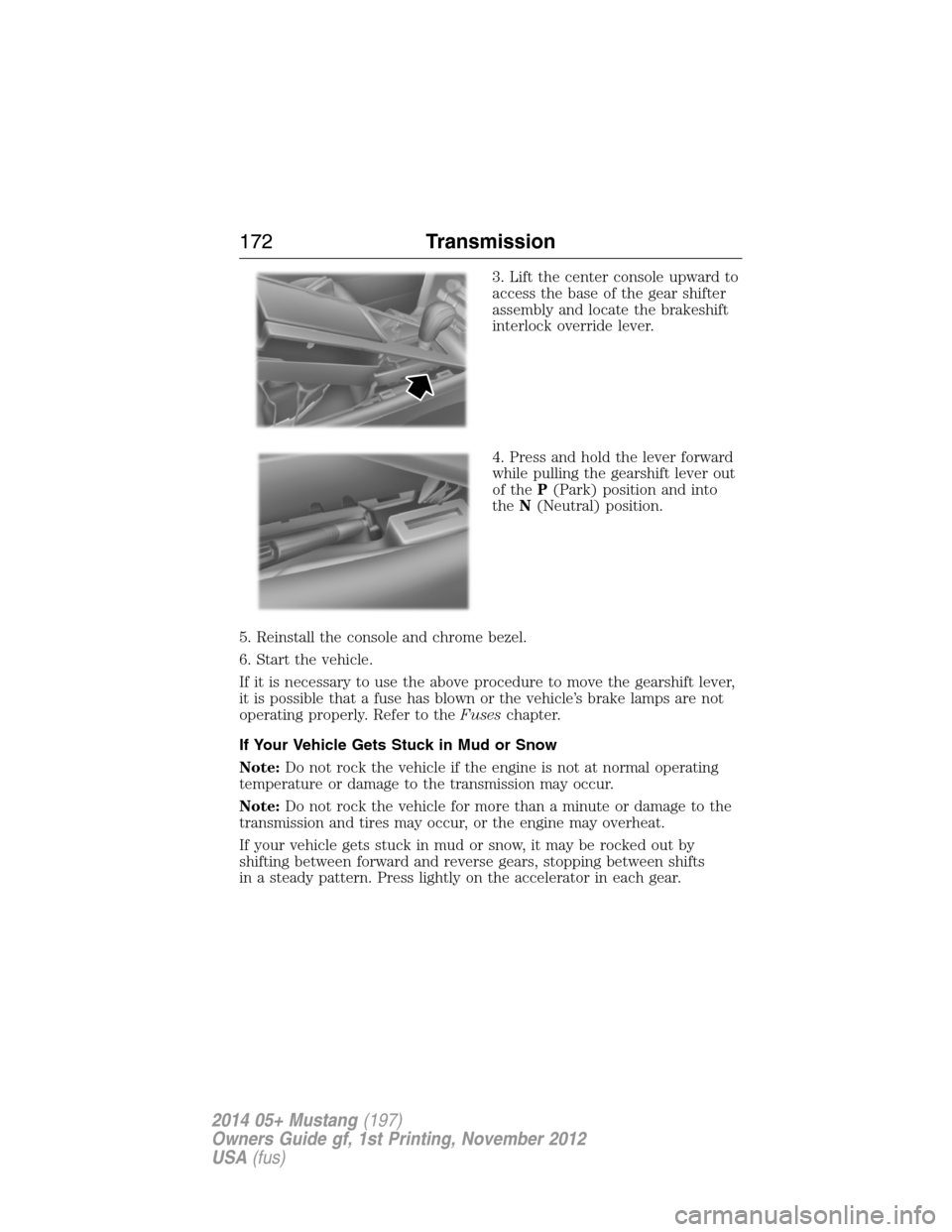
3. Lift the center console upward to
access the base of the gear shifter
assembly and locate the brakeshift
interlock override lever.
4. Press and hold the lever forward
while pulling the gearshift lever out
of theP(Park) position and into
theN(Neutral) position.
5. Reinstall the console and chrome bezel.
6. Start the vehicle.
If it is necessary to use the above procedure to move the gearshift lever,
it is possible that a fuse has blown or the vehicle’s brake lamps are not
operating properly. Refer to theFuseschapter.
If Your Vehicle Gets Stuck in Mud or Snow
Note:Do not rock the vehicle if the engine is not at normal operating
temperature or damage to the transmission may occur.
Note:Do not rock the vehicle for more than a minute or damage to the
transmission and tires may occur, or the engine may overheat.
If your vehicle gets stuck in mud or snow, it may be rocked out by
shifting between forward and reverse gears, stopping between shifts
in a steady pattern. Press lightly on the accelerator in each gear.
172Transmission
2014 05+ Mustang(197)
Owners Guide gf, 1st Printing, November 2012
USA(fus)
Page 174 of 461
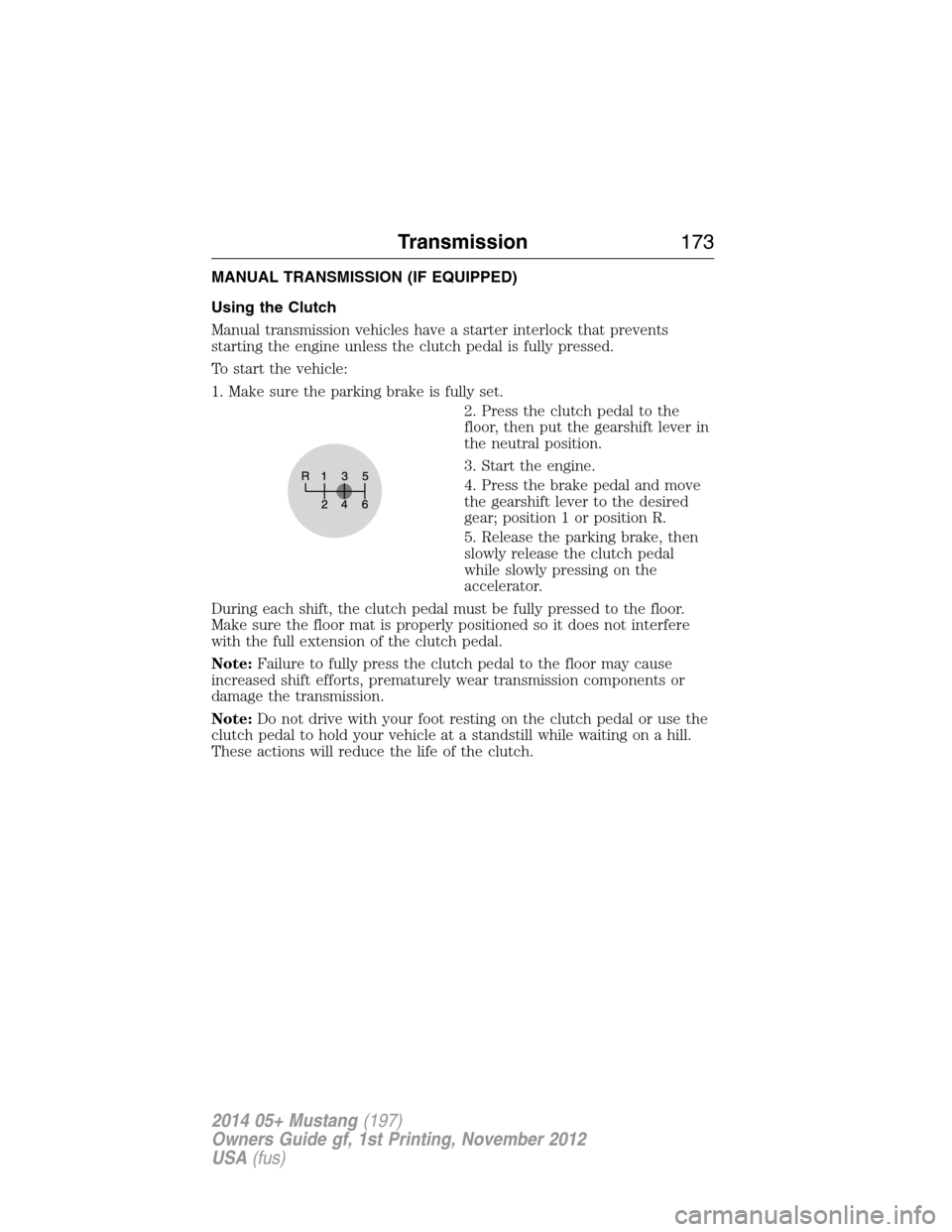
MANUAL TRANSMISSION (IF EQUIPPED)
Using the Clutch
Manual transmission vehicles have a starter interlock that prevents
starting the engine unless the clutch pedal is fully pressed.
To start the vehicle:
1. Make sure the parking brake is fully set.
2. Press the clutch pedal to the
floor, then put the gearshift lever in
the neutral position.
3. Start the engine.
4. Press the brake pedal and move
the gearshift lever to the desired
gear; position 1 or position R.
5. Release the parking brake, then
slowly release the clutch pedal
while slowly pressing on the
accelerator.
During each shift, the clutch pedal must be fully pressed to the floor.
Make sure the floor mat is properly positioned so it does not interfere
with the full extension of the clutch pedal.
Note:Failure to fully press the clutch pedal to the floor may cause
increased shift efforts, prematurely wear transmission components or
damage the transmission.
Note:Do not drive with your foot resting on the clutch pedal or use the
clutch pedal to hold your vehicle at a standstill while waiting on a hill.
These actions will reduce the life of the clutch.
Transmission173
2014 05+ Mustang(197)
Owners Guide gf, 1st Printing, November 2012
USA(fus)
Page 177 of 461
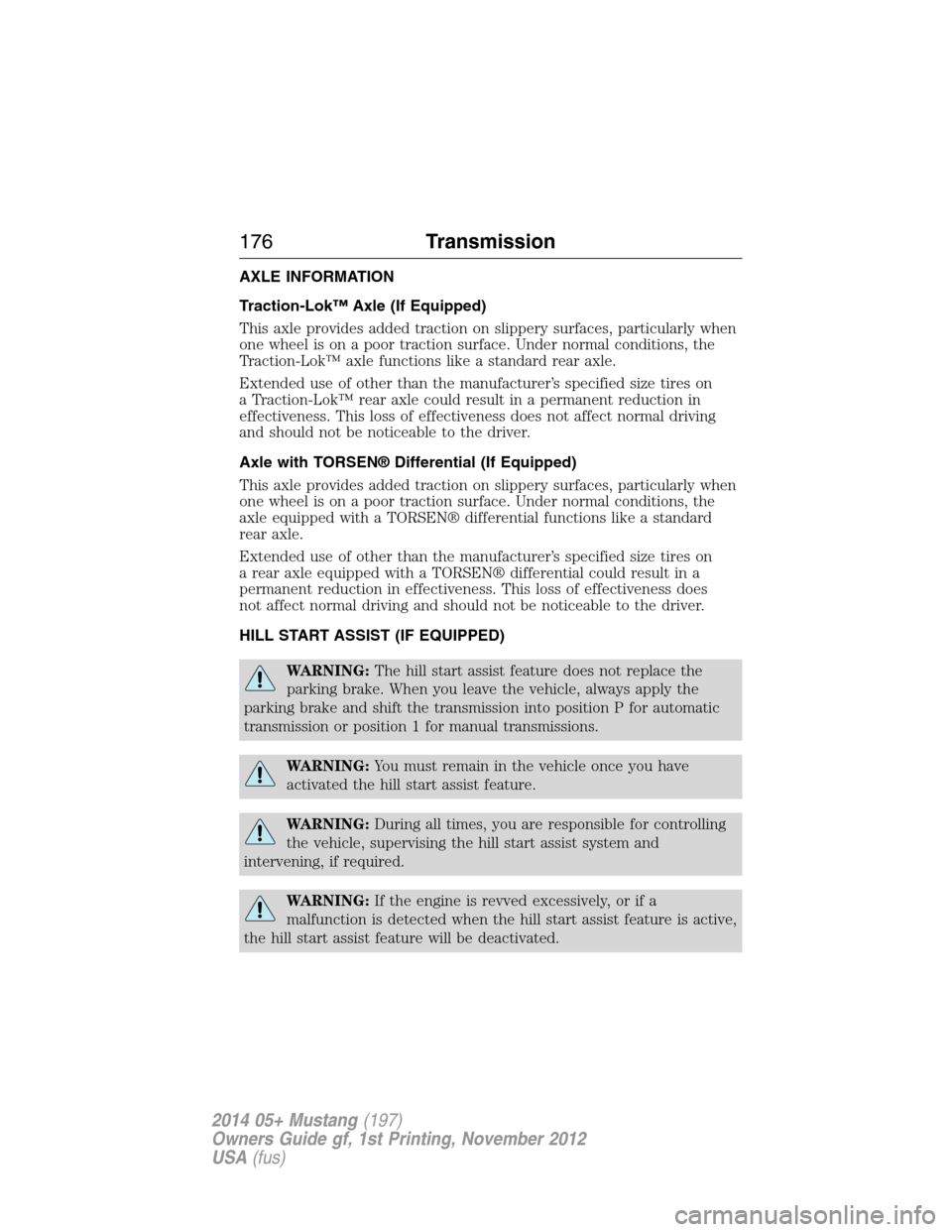
AXLE INFORMATION
Traction-Lok™ Axle (If Equipped)
This axle provides added traction on slippery surfaces, particularly when
one wheel is on a poor traction surface. Under normal conditions, the
Traction-Lok™ axle functions like a standard rear axle.
Extended use of other than the manufacturer’s specified size tires on
a Traction-Lok™ rear axle could result in a permanent reduction in
effectiveness. This loss of effectiveness does not affect normal driving
and should not be noticeable to the driver.
Axle with TORSEN® Differential (If Equipped)
This axle provides added traction on slippery surfaces, particularly when
one wheel is on a poor traction surface. Under normal conditions, the
axle equipped with a TORSEN® differential functions like a standard
rear axle.
Extended use of other than the manufacturer’s specified size tires on
a rear axle equipped with a TORSEN® differential could result in a
permanent reduction in effectiveness. This loss of effectiveness does
not affect normal driving and should not be noticeable to the driver.
HILL START ASSIST (IF EQUIPPED)
WARNING:The hill start assist feature does not replace the
parking brake. When you leave the vehicle, always apply the
parking brake and shift the transmission into position P for automatic
transmission or position 1 for manual transmissions.
WARNING:You must remain in the vehicle once you have
activated the hill start assist feature.
WARNING:During all times, you are responsible for controlling
the vehicle, supervising the hill start assist system and
intervening, if required.
WARNING:If the engine is revved excessively, or if a
malfunction is detected when the hill start assist feature is active,
the hill start assist feature will be deactivated.
176Transmission
2014 05+ Mustang(197)
Owners Guide gf, 1st Printing, November 2012
USA(fus)
Page 178 of 461

This feature makes it easier to pull away when the vehicle is on a slope
without the need to use the parking brake. When this feature is active, the
vehicle will remain stationary on the slope for two to three seconds after
you release the brake pedal. This allows you time to move your foot from
the brake to the accelerator pedal. The brakes are released automatically
once the engine has developed sufficient drive to prevent the vehicle from
rolling down the slope. This is an advantage when pulling away on a slope,
(for example from a car park ramp, traffic lights or when reversing uphill
into a parking space).
This feature is activated automatically on any slope that can result in
significant vehicle rollback. This feature will not operate if the parking
brake is activated.
Using Hill Start Assist
Note:If the engine is revved excessively, hill start assist will be
deactivated.
1. Press the brake pedal to bring the vehicle to a complete standstill.
Keep the brake pedal pressed.
2. If the sensors detect that the vehicle is on a slope, the hill start assist
feature will be activated automatically.
3. When you remove your foot from the brake pedal, the vehicle will
remain on the slope without rolling away for approximately two or
three seconds. This hold time will automatically be extended if you are
in the process of driving off.
4. Drive off in the normal manner. The brakes will be released
automatically.
Disabling and Enabling the Hill Start Assist Feature
Your vehicle comes with hill start assist already enabled. If desired, you
can disable the feature by following the procedure below.
The following procedure must be completed within 45 seconds or the
process will have to be repeated. Begin this procedure with the ignition
turned off. This procedure is for both disabling and enabling the hill start
assist system.
1. Apply the parking brake to make sure the vehicle is not moving.
2. Turn the ignition on.
3. Place the vehicle in neutral gear.
4. Slowly press and release the brake pedal five times – make sure the
brake pedal is completely released each time.
Transmission177
2014 05+ Mustang(197)
Owners Guide gf, 1st Printing, November 2012
USA(fus)
Page 180 of 461
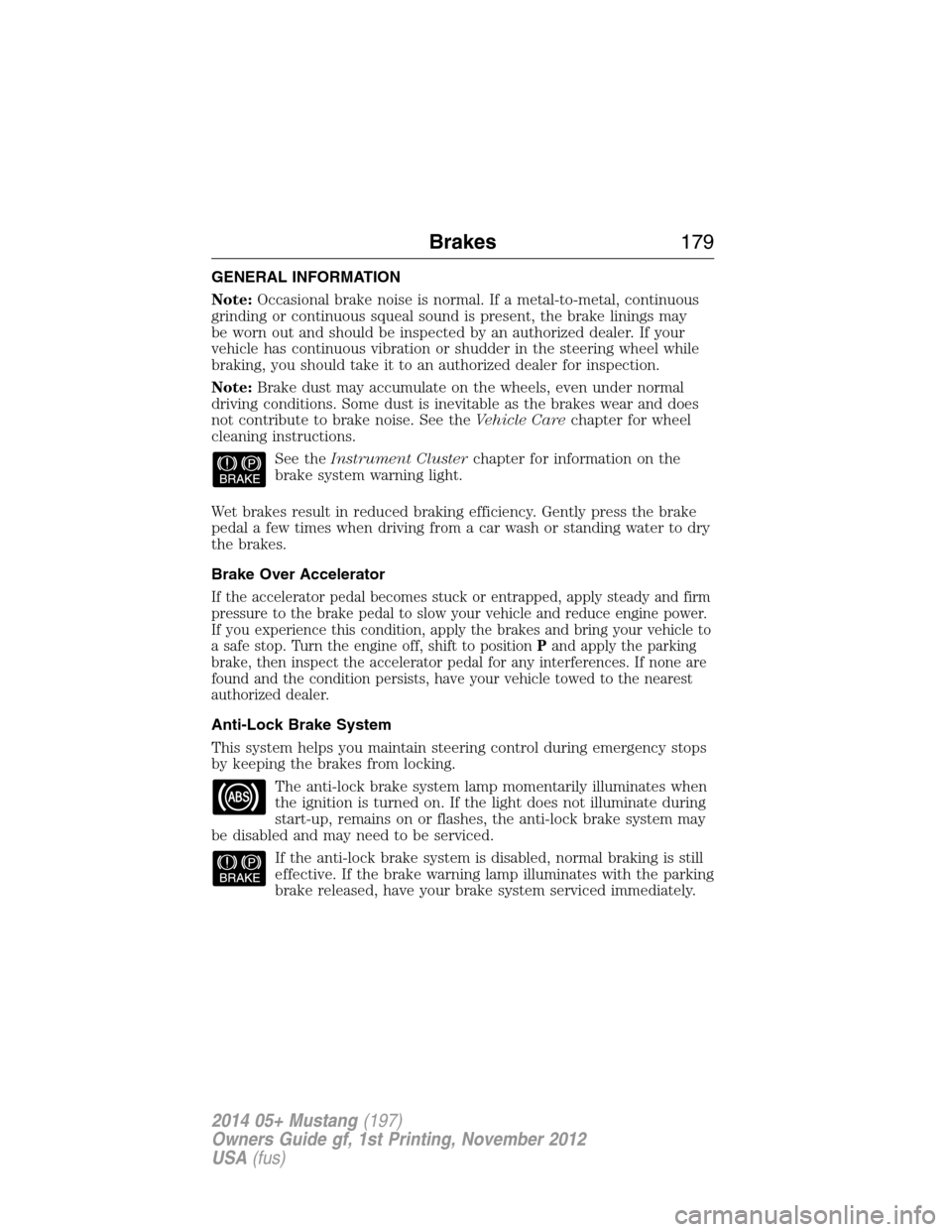
GENERAL INFORMATION
Note:Occasional brake noise is normal. If a metal-to-metal, continuous
grinding or continuous squeal sound is present, the brake linings may
be worn out and should be inspected by an authorized dealer. If your
vehicle has continuous vibration or shudder in the steering wheel while
braking, you should take it to an authorized dealer for inspection.
Note:Brake dust may accumulate on the wheels, even under normal
driving conditions. Some dust is inevitable as the brakes wear and does
not contribute to brake noise. See theVehicle Carechapter for wheel
cleaning instructions.
See theInstrument Clusterchapter for information on the
brake system warning light.
Wet brakes result in reduced braking efficiency. Gently press the brake
pedal a few times when driving from a car wash or standing water to dry
the brakes.
Brake Over Accelerator
If the accelerator pedal becomes stuck or entrapped, apply steady and firm
pressure to the brake pedal to slow your vehicle and reduce engine power.
If you experience this condition, apply the brakes and bring your vehicle to
a safe stop. Turn the engine off, shift to positionPand apply the parking
brake, then inspect the accelerator pedal for any interferences. If none are
found and the condition persists, have your vehicle towed to the nearest
authorized dealer.
Anti-Lock Brake System
This system helps you maintain steering control during emergency stops
by keeping the brakes from locking.
The anti-lock brake system lamp momentarily illuminates when
the ignition is turned on. If the light does not illuminate during
start-up, remains on or flashes, the anti-lock brake system may
be disabled and may need to be serviced.
If the anti-lock brake system is disabled, normal braking is still
effective. If the brake warning lamp illuminates with the parking
brake released, have your brake system serviced immediately.
Brakes179
2014 05+ Mustang(197)
Owners Guide gf, 1st Printing, November 2012
USA(fus)
Page 182 of 461
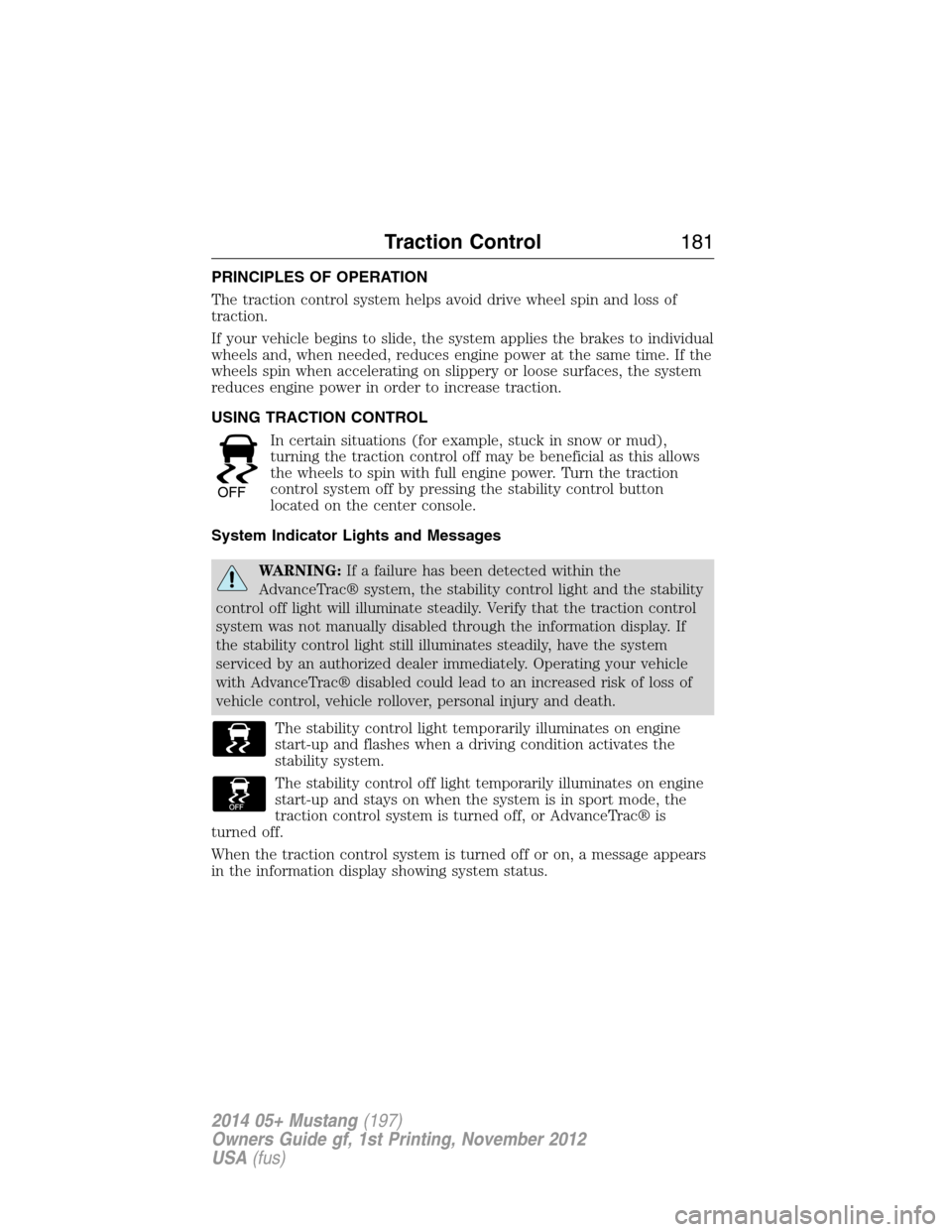
PRINCIPLES OF OPERATION
The traction control system helps avoid drive wheel spin and loss of
traction.
If your vehicle begins to slide, the system applies the brakes to individual
wheels and, when needed, reduces engine power at the same time. If the
wheels spin when accelerating on slippery or loose surfaces, the system
reduces engine power in order to increase traction.
USING TRACTION CONTROL
In certain situations (for example, stuck in snow or mud),
turning the traction control off may be beneficial as this allows
the wheels to spin with full engine power. Turn the traction
control system off by pressing the stability control button
located on the center console.
System Indicator Lights and Messages
WARNING:If a failure has been detected within the
AdvanceTrac® system, the stability control light and the stability
control off light will illuminate steadily. Verify that the traction control
system was not manually disabled through the information display. If
the stability control light still illuminates steadily, have the system
serviced by an authorized dealer immediately. Operating your vehicle
with AdvanceTrac® disabled could lead to an increased risk of loss of
vehicle control, vehicle rollover, personal injury and death.
The stability control light temporarily illuminates on engine
start-up and flashes when a driving condition activates the
stability system.
The stability control off light temporarily illuminates on engine
start-up and stays on when the system is in sport mode, the
traction control system is turned off, or AdvanceTrac® is
turned off.
When the traction control system is turned off or on, a message appears
in the information display showing system status.
OFF
Traction Control181
2014 05+ Mustang(197)
Owners Guide gf, 1st Printing, November 2012
USA(fus)
Page 184 of 461

AVehicle without AdvanceTrac®
skidding off its intended route.
BVehicle with AdvanceTrac®
maintaining control on a slippery
surface.
USING ADVANCETRAC®
The system automatically is enabled when you start your engine. The
electronic stability control portion of the system is disabled when the
transmission is in positionRor, on some models, if the stability control
button is pressed and held for more than five seconds when the brakes
are applied and the vehicle is at a stop. The traction control portion of
the system can be turned off independently. See theTraction Control
chapter.
AdvanceTrac® Features
Button
functionsModeIcon
statusESC TCS
Default at
start-up—On during
bulb
checkEnabled Enabled
Button pressed
momentarilyTraction
control offOn Enabled Disabled
Stability Control183
2014 05+ Mustang(197)
Owners Guide gf, 1st Printing, November 2012
USA(fus)
Page 193 of 461

STEERING
Electric Power Steering
WARNING:Obtain immediate service if a system error is
detected. You may not notice any difference in the feel of your
steering, but a serious condition may exist. Failure to do so may result
in loss of steering control.
Note:Your vehicle is equipped with an electric power-assisted steering
system. There is no fluid reservoir to check or fill.
The electric power steering system has diagnostic checks that
continuously monitor the system to ensure proper operation of the
electronic system. When an electronic error is detected, a message will
be displayed in the information display. If this happens, stop the vehicle
in a safe place, and turn off the engine. After at least 10 seconds, reset
the system by restarting the engine, and watch the information display
for a steering message. If a steering message returns, or returns while
driving, take the vehicle to your dealer to have it checked.
If your vehicle loses electrical power while you are driving (or if the
ignition is turned off), you can steer the vehicle manually, but it takes
more effort. Extreme continuous steering may increase the effort it takes
for you to steer. This occurs to prevent internal overheating and permanent
damage to your steering system. If this should occur, you will neither lose
the ability to steer the vehicle manually nor will it cause permanent
damage. Typical steering and driving maneuvers will allow the system
to cool and steering assist will return to normal.
Steering Tips
If the steering wanders or pulls, check for:
•an improperly inflated tire
•uneven tire wear
•loose or worn suspension components
•loose or worn steering components
•improper vehicle alignment
A high crown in the road or high crosswinds may also make the steering
seem to wander/pull.
192Driving Aids
2014 05+ Mustang(197)
Owners Guide gf, 1st Printing, November 2012
USA(fus)